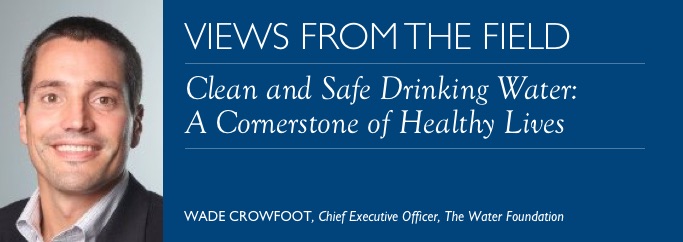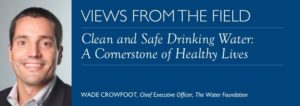
Many of us take water for granted in our daily lives. I know I do. Most of us woke up this morning, drank a glass of water, brushed our teeth, took a shower, and washed up our kids before school. These everyday activities maintain our health. We know that many people in poorer parts of the world lack clean water for sanitation. However, we are largely unaware that millions of Americans similarly suffer from a lack of clean and safe drinking water.
The tragic drinking water crisis in Flint, Michigan caught public attention. And for good reason: many Flint residents were exposed to lead levels ten to fifty times above what is allowed by federal law. What is less known is that Flint is the proverbial canary in the coal mine, warning of a grave health problem national in scope.
In California, where our foundation is based, upwards of 1 million residents lack access to clean and safe drinking water in their homes. Their drinking water is contaminated by nitrates from fertilizer, industrial solvents, naturally-occurring arsenic, and other harmful elements. Most of these residents live in poor, rural communities that receive their drinking water from small water agencies that pump groundwater. These agencies lack the funding, technical understanding, and managerial expertise to treat contamination and deliver clean water.
This drinking water crisis is not unique to California. Across the country, communities are threatened by drinking water problems:
- Agricultural runoff has led to high levels of nitrates in groundwater supplies in dozens of states. Nitrogen is an essential element of fertilizer to grow food and is found in livestock waste, and failure to control it threatens drinking water supplies in hundreds of communities across the country.
- Toxic algal blooms foul water bodies across the country, from Lake Erie to small rivers and lakes, and threaten water supplies. These blooms can occur when nutrients such as phosphorus and nitrogen applied to lawns and farmlands flow into a water body and ‘overfeed’ the algae that exist normally in the environment.
- Industrial chemicals with poorly understood impacts on human health are increasingly found in drinking water supplies. These “contaminants of emerging concern” are not yet regulated by the federal government, and many states and local governments are struggling to figure out how to respond to residents’ concerns about them.
- Lead contamination from corroded distribution pipes is a widespread threat in thousands of cities and towns across the country. It occurs in pipes owned by water agencies, as well as lead service lines that are the responsibility of homeowners.
Data on drinking water pollution is generally not well tracked by governments, due, in part, to the many and varied sources of contamination. In response, environmental and public health watchdogs such as the Environmental Working Group and the Natural Resources Defense Council have stepped into the breach to aggregate and visualize data on drinking water problems. The map below shows counties where water agencies have violated the federal Lead and Copper Rule as of 2016. All told, 27 million people, or 1 in every 12 Americans, are served by a drinking water system with recent health-based violations.

Federal law has proven insufficient to protect drinking water sources. The federal Safe Drinking Water Act sets maximum levels for contaminants in drinking water and requires regular water testing, which has driven large water agencies to improve the safety of their water supplies. But this law has important limitations. It does not extend to communities, homes, or schools that rely on private groundwater wells, nor to very small systems that serve less than 25 people. It also only applies to certain regulated contaminants, and it can take decades for new contaminants to be regulated. Chromium-6, a carcinogenic industrial chemical made notorious by the film Erin Brockovich, has been detected in drinking water supplies for more than 250 million Americans, but remains unregulated by the federal government.
In practice, the quality of drinking water varies greatly depending on where the water comes from and what system delivers it. In essence, where a person lives in our country can define whether the water that he or she receives is clean and safe. This reality represents yet another social determinant of health: thousands of small, poor communities in rural areas across the country are plagued by unsafe water, and poor areas in large metropolitan areas are also under threat. The highest levels of contamination tracked in the Environmental Working Group’s national tap water databased were found in East Los Angeles, a poor area in one of the wealthiest cities in the country. Drinking water quality not only represents a public health crisis but reflects deep inequities and underinvestment in poor communities.
Great potential exists for philanthropy to help solve this crisis. Foundations can engage by:
- building public awareness about drinking water challenges across the country and verifying that local drinking water supplies are indeed safe;
- identifying solutions to update water infrastructure in poor communities, and
- securing policy and regulatory reform at the state level, and ultimately the federal level, that strengthen drinking water standards and enforcement.
In this polarized political environment, ensuring clean and safe drinking water for all Americans transcends partisanship and ideology. In a recent poll that our foundation commissioned on water issues in the American West, 88 percent of respondents strongly support ensuring safe, affordable drinking water for everyone. Americans rightly recognize the importance of tackling this crisis, and foundations can and should lead the way.

